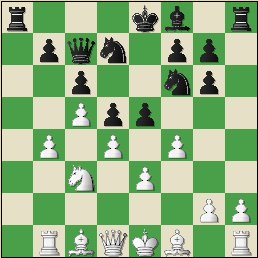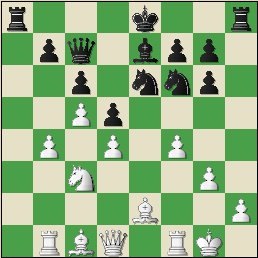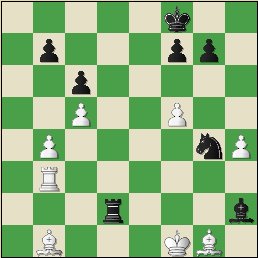WCh Elista RUS (9), 07.10.2006
[Malcolm Pein]
(Thanks to Mark Crowther,
The Week In Chess, and Malcolm Pein for commentary and analysis)
1.d4 d5 2.c4 c6 3.Nf3 Nf6 4.e3 Bf5 5.Nc3 e6 6.Nh4 Bg6 A big surprise to me. Kramnik plays the same line that led to disaster in game 9. 7.Nxg6 hxg6 8.Rb1N An interesting choice which has the benefit of being new but it does rule out 0-0-0 for White which can be a useful option There is a huge choice of moves here. A sample: [ 8.Qc2; 8.Qb3; 8.cxd5; 8.g3; 8.Bd3; 8.Bd2; 8.a3 Nbd7 9.g3 Be7 10.f4 dxc4 11.Bxc4 0-0 12.e4 was much better for White in game 9 of the match and led to a fairly easy Topalov victory.] 8...Nbd7 9.c5 a5 Played after about 5 minutes thought. Black needs this file for counterplay 10.a3 [ 10.f4 b6! and b4 is not possible] 10...e5! Again essential to get counterplay before f2-f4 rules it out 11.b4 axb4 12.axb4 Qc7 13.f4 Diagram
The same strategic idea from Topalov. As in game 9 White tries to take over the whole board. Topalov was moving quickly again.
13...exf4 [ 13...Nh5 Was a wild idea which Kramnik may have avoided on the principle that Topalov might have analysed it at home 14.Ne2
a) 14.fxe5 Ng3 15.Rg1 Rxh2=/+ 16.Qf3 Be7 17.Bd3 Bh4 18.Kd1~~;
b) 14.Qg4? Be7!? 15.fxe5 Ng3!! is a very attractive idea which is much better for Black 16.Rg1 Rxh2-/+ 17.Qxg3? Bh4;
c) 14.Qf3!? e4 Blocking the position gives White a free hand on the queenside so Black needs to follow up with b7-b5 15.Qf2 b5 (
c) 15...Be7! 16.h4
(c) 16.g3 Nxg3!; c) 16.b5 Ng3!) 16...Nhf6 17.Be2~~) 16.Nxb5!? cxb5 17.Bxb5; ]
14.exf4 Be7 [ 14...Ne4 15.Nxe4 dxe4 16.d5 A great position, all the White pieces are on the back row but he is better]
15.Be2 Nf8 16.0-0 Ne6 17.g3 Diagram
Black is fully mobilised and although he does not have much space his knights are OK and his rooks active. White's plan is b4-b5 but he never gets to carry it out to any great effect
17...Qd7! Preparing Ne4 which will force open the d file and tactically preventing b4-b5
18.Qd3 [ 18.Be3 Ne4 19.Nxe4 dxe4 20.Bc4 Nc7!=; 18.b5 Nxc5! 19.dxc5 Bxc5+ 20.Kh1
( 20.Kg2 Qh3+ 21.Kf3 Ng4-+) 20...Qh3]
18...Ne4! Kramnik is always comfortable with the queens off even if he is going to be slightly worse.
19.Nxe4 dxe4 20.Qxe4 Qxd4+ 21.Qxd4 Nxd4 22.Bc4 The danger for Black in these positions is the unchallenged white squared bishop which has targets on f7, g6, b7 and c6.
22...0-0 23.Kg2 Ra4 24.Rd1 Rd8 [ 24...Bxc5 25.Be3 Ne6 26.Bb3! Rxb4 27.Bxc5 Nxc5 28.Bxf7++-]
25.Be3 Bf6 Black's activ ity compensates for the bishop pair and White is only marginally better
[ 25...Nc2!? 26.Rxd8+ Bxd8 27.Bf2 Nxb4
( 27...Rxb4? 28.Bb3! Na3 29.Bxf7+) 28.Rd1 Bf6 29.Rd7 Nd5 with good drawing chances 30.Bxd5 cxd5 31.Rxb7 Rc4]
26.g4 Kf8 Interesting, Kramnik is comfortable and avoids
[ 26...Ra3 27.Bxd4 Bxd4
( 27...Rxd4 28.Rxd4 Bxd4 29.Rd1 Be3 30.Rd7+/-) 28.Bb3 Raa8 29.Rd3 Bf6=]
27.Bf2 Ne6 28.Rxd8+ Bxd8 going to c7
29.f5!? Again attack at all costs but this relinquishes any advantage and was played pretty quickly
[ 29.Bxe6 fxe6 30.h4 Bc7 31.Kf3 Ke7 32.Be3 Would give White no winning chances despite Black weakened structure but; 29.Be3 Bc7 30.Kf3 Was the careful way to play then if 30...Ra3 31.Rb3 Rxb3 32.Bxb3 Bxf4 33.Bxf4 Nd4+ 34.Ke4 Nxb3 35.Kd3 traps the knight]
29...gxf5 30.gxf5 Nf4+ [ 30...Ng5 was also OK but Kramnik has a nice reconfiguration of his pieces in mind. This is second nature to him.]
31.Kf3 Nh5 The optimal setup might be Be5 and Nf6
32.Rb3 Bc7 33.h4 Nf6 34.Bd3 Nd7 35.Be4 Preserving the bishop
35...Ne5+ 36.Kg2 Ra2 Black is slightly better now, the pawn on f5 ruins the white squared bishop, this is the key difference. f5 is actually a square the bishop would like to go to, c8 would beckon
37.Bb1 Rd2 38.Kf1 Ng4 39.Bg1 [ 39.Be1 Also holds]
39...Bh2 Diagram
40.Ke1 White has been driven back substantially over the last dozen moves and Black is slightly better but his rook, bishop and knight are not going to overwhelm White's rook, two bishops and king.
40...Rd5 [ 40...Rg2 Many commentators and even strong players who were letting their engines think for them thought this was stronger but in fact in practical terms its weaker and gives no winning chances whatsoever, Kramnik's move continues the fight 41.Bd4 Be5 42.Bxe5 Nxe5 43.f6! gxf6
( 43...g6 44.Ra3) 44.Bf5=]
41.Bf2 Around here it was clear the best Kramnik could get was a pawn up in a rook and opposite coloured bishop ending. However the b4-b5 break brings about a queenside liquidation so there are very few winning chances.
41...Ke7 42.h5 Nxf2 43.Kxf2 Kf6 44.Kf3 Rd4 45.b5 Rc4 46.bxc6 bxc6 47.Rb6 Rxc5 48.Be4 Kg5 Its a matter of when, not if the draw is agreed.
49.Rxc6 Ra5 Kramnik plays on, there surely can't be anything here though.
50.Rb6 Ra3+ 51.Kg2 Bc7 52.Rb7 Rc3 53.Kf2 Kxh5 54.Bd5 f6 55.Ke2 Kg4 56.Be4 If Black could organise Be5, Kf4 and Rg3 he might have some practical chances but because White can always threaten to swop rooks he can hold easily
56...Kf4 57.Bd3 Rc5 58.Rb4+ Kg3 59.Rc4 Re5+ 60.Re4 Diagram
60...Ra5 [ 60...Bb6 Even if Black reaches bishop, king plus e and g against bishop and king the endgame is an easy draw 61.Rxe5 fxe5 62.Be4
( 62.Bc4 Kf4 63.Be6=) 62...Kf4 63.Kd3 even losing the pawn is a draw 63...Bc5 64.Bd5 Kxf5 65.Be4+ Kf4 66.Bg6=]
61.Re3+ Kg2 62.Be4+ Kh2 63.Rb3 Ra2+ 64.Kd3 Bf4 65.Kc4 Re2 66.Kd5 1/2-1/2




Comments